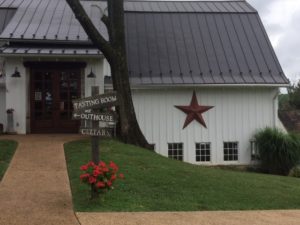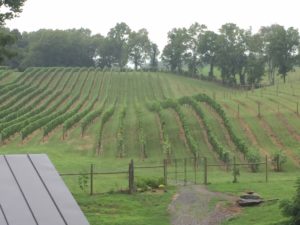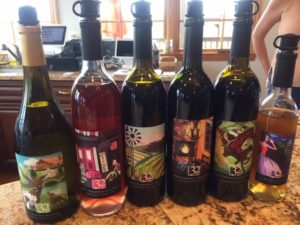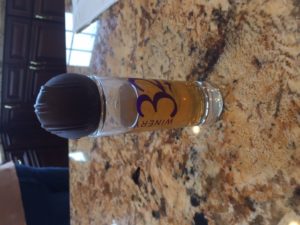On August 1st I signed copies of my new third edition of Beyond Jefferson’s Vines (the definitive book on Virginia wine) at Breaux Vineyards in northern Loudoun County, so I stayed for a couple of nights and visited a half-dozen other wineries, some of which were new entries in my book that I hadn’t visited before, and some which had only recently opened.
My timing was good; many Loudoun wineries were only just re-opening for doing tastings or flights in Phase III. You need to carefully check a winery’s website to see if they are actually serving wine at all, before you drive all the way out there. Overall it was fun and I’m very bullish on the ’18 and ’19 white wines from Loudoun County with its cooler climate and higher acidity than in Central Virginia, but these were VERY different vintages and so you have very different styles, but both welcome.
The 2018 Vintage (the cloudy one)
2018 was universally acknowledged as being the worst growing season the industry has experienced. However, due to increasing professionalism in the vineyard and winery, most wineries managed to make at least a couple of respectable white wines; some made brilliant whites. However, the whites were hard and high in acid and have only just in the last month or so become pleasant to drink. They are reminiscent of wines from the Finger Lakes, with delicate but vivid fruit aromas and flavors, and almost piercing acidity. They also seem to have a tongue-coating viscocity. These will make good food pairing whites, and you can even lay many of them down for a few years since the acidity is so high, even though you could enjoy them now. Also, many Virginia wineries didn’t make a red wine in this cool wet vintage, but they were able to make good rose wines instead.
The 2019 Vintage (the hot, sunny one)
By contrast, the hot, sunny 2019 vintage produced rich, ripe wines across the board. The 2019 whites are juicy and forward, a little higher than usual in alcohol and a little lower in acid, but very appealing and packed with varietal fruit character. You can quaff a ’19 white by itself as an aperitif and then serve an ’18 white to complement a dinner with its higher acidity.
Wineries Near Purcellville
My first visit was 8 Chains North Vineyard, where I was pleased to see find a nice flight poured in attractive clear plastic “cups” which I poured one by one into my wineglass to sample. Quality was high across the board. Due to the 2016 freeze, they brought in a Syrah and Tempranillo from Yakima, WA but the rest of the wine was locally sourced. Favorites include:
*’19 Loco Vino: 30% Traminette, 30% Viognier, and 40% Sauvignon Blanc, all Loudoun County fruit. The nose showed a fun, fascinating tension between the aromatic/fruity varieties and the herbal/grassy notes of the S. blanc. On the palate, fresh, lively, just a touch of residual sugar but versatile for solo sipping, matching with cheese or a wide variety of foods.
*’17 Chardonnay: estate fruit, sur-lie for 10 months in French oak. Nose: a rich Meursault style, a touch of butter and diacetyl, vanilla and apple. On the palate, reminiscent of white Burgundy but clean with a fresh finish and apple and pear flavors; multi-dimensional but lively.
*’16 Cabernet Sauvignon Local, single vineyard. Nose: fruit-driven, fresh red cassis. Palate: hefty American oak dominates, but still fresh, vivid red cassis beneath. A little clumsy but the fruit is so nice I’m still giving it a star.
The Barns at Hamilton Station
This winery is aptly named for the two dairy barns on the site dating to 1910 (the tasting room is in one). Operations Manager Susan Pratt took me through the tasting. Owners Andrew Finaldi and his wife Maryanne are partners in Michael Shaps Wineworks (Mike Heny is the winemaker) but they also own and lease vineyards in Loudoun County. Highlights:
*’18 Viognier Stainless steel. Nose: typical floral notes of honeysuckle, clementine and tangerine/citrus as well. Palate: fresh apricot flavor, fleshy texture, nice bright acidity, shows terroir and the vintage well. Just coming together now, this Viognier can also age.
*’17 Chardonnay 100% new French oak, with malolactic fermentation. Nose: taut, tight, racy lemon/mineral notes. Palate: layered from the MLF but still holds racy lemon fruit, great acidity in the forefront. Still young and evolving; good integration.
*’19 Rosé: a 50/50 blend of both Cabernets and 5% Roussane. Nose: young, subtle but clean red cherry, fresh. Palate: smooth but dry, clean, fresh, delicate red cherry. Susan says it’s “selling like hotcakes.”
**’14 Petit Verdot fruit from the Monticello AVA. Rare treat to taste a mature Petit Verdot from a classic, balanced vintage. Nose: loads of violets and fresh blackberries. Palate: very juicy, round and smooth with violets and blackberries, no obvious oak, mature, a bit of licorice on the finish. Lovely, classy varietal character.
Nose: black fruits, vanilla. Palate: same thing, large volume BIG but ripe, smooth tannins, juicy, well-balanced, good example of a Virginia varietal Petit Verdot. Still young, impressive.
*’17 Cabernet Franc (Monticello AVA sourced). Nose: fresh, clean, red cherry then smoke, tobacco, herb but gentle. Palate: subtle at first, then flavor, texture grows. Red cherry, plum, herbs and spice. Stylish, easy to drink but grows on the palate.
’17 Cabernet Sauvignon (15% Cabernet Franc). Nose: red cassis, herbs, hint of caramel? then earth and herbs; delicate but complex. Palate: elegant red cassis, smooth tannins, a bit of smoke, and herb, stylish but not overdone.
Three Creeks Winery is a short drive from the Barns at Hamilton Station, where the tasting room/cellar is also located in a barn, handsomely re-finished. Owners John and P.J. Lawrence have lived in Loudoun County for the last 24 years. They took the enology/viticulture course through Piedmont Community College in Charlottesville, then learned of the program at Vint Hill where they worked with winemaker Ashton Lough to make their own barrel of wine. They then contracted with him to be their winemaker at the recently opened Three Creeks winery and his experience and skill are evident across the product line. Highlights:
**’19 Vidal blanc: Nose: clean, fresh apple and pear aromas, good varietal typicity. Palate: bright with vibrant fruit/acid balance, drinks much like a Riesling with firm acidity and solid fruit. Young but vibrant and promising.
**’19 Chardonnay Nose: subtle, some malolactic hints, fresh lemon and apple. Palate: layered, bright, vibrant and lively apple/lemon fruit and acidity. No oak flavor, just a hint of malolactic that blunts the acidity and adds a touch of creaminess to the mid-palate. Young but promising, will age well.
**’18 Chardonnay (aged in neutral oak, sur-lie). Nose: getting mature, nice apple/pear and malolactic hints. Palate: layered, clean, complex, rich with malolactic notes but no butter. Vibrant apple and lemon flavors. Reminds me of a Puligny-Montrachet style white Burgundy.
*’18 Viognier: Nose: subtle, clean locust blossom, fresh apricot. Palate: clean, fresh, vibrant, with apricot and white peach flavors. Firm acidity for the variety, impressive balance.
A great testament to winemaker Ashton Lough’s talent is that he made two very fine reds for Three Creeks, both from the tough 2018 vintage, but both still very high in quality:
**’18 Melange Rouge: This is a blend of the two Cabernets, Merlot and Petit Verdot. The color is vibrant ruby. Nose: very clean, impressively ripe red and black fruits with violets. Palate: solid red/black fruits, firm but not edgy acidity, a hint of smoke on the finish. Young, but so far the best of the ’18 Virginia reds I’ve tasted. Needs another six months but impressive.
**’18 Petit Verdot: Color impressively dark and vivid. Nose: lovely floral notes with brambleberries. Palate: firm acidity but flavors very true to the variety, chewy but solid fruit. Hats off for such character in such a crummy vintage.
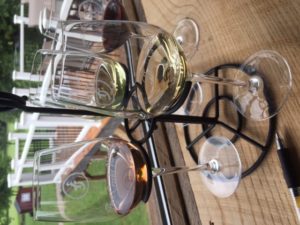
Flights at Three Creeks Winery are served on an elegant wrought iron glass holder, color-coded to identify the wines.
Potomac Area Wineries
Winery 32, with a view of Maryland across the Potomac, has an interesting and touching story. It gets its name from the 32 peach trees that line the drive (and whose fruit is used in their wonderful peach cordial!), the property is 32 acres, and the owners, Roxanne and Michael Moosher, planted the vines on their 32nd anniversary.
I visited on a very humid, misty cool August morning, and tasted through the product line. Winery 32 is one of the few Virginia wineries to proudly make a 100% Chardonel, and more wineries should do it, because it’s more sustainable (in the vineyard) than Chardonnay, which is one of its parents (the other is Seyval blanc).
One unique and worthwhile feature of Winery 32 is that the Moosher’s daughter Chantal designs all the winery’s labels in a colorful Magical Realism style. Further, she may be commissioned by customers to design a custom label for the wines they buy.
That might sound cheesy, but I found the labels are very compelling, colorful and truly artistic (see photo). I tend to be the kind of man who wants the labels to be all about the contents, but I have to admit, the bright freshness of the art adds a lot to the appeal of the bottle, and the wines. Tasting Highlights:
**Chardonel ’19: This was fermented in stainless steel with malolactic. Nose: light, lemony, fresh but elegant. Palate: bright, vivid, like a Macon Chardonnay, bursting with lemon/citrus and vibrant acidity. The malolactic richness is in the background. Very stylish argument for more Chardonel in Virginia, and for drinking it in the summer.
Chambourcin Rose ’17 (5% Vidal) A combinatino of white and red wine yeasts were used; NT202 for red, and Elixir for white. Nose: complex mix of cotton candy, pommegranate, strawberry and raspberry notes (they are shortly moving on to their ’19 rose). Palate: juicy, full-bodied but round and smooth with like flavors. Note: when I opened the bottle I brought home, it was reduced, meaning slightly stinky, so with a little oxygen and copper, it was redeemed. By now, they should be on to the ’19 vintage, but if you have a ’17, just decant it and let it stand until the funky stuff blows off.
***Cabernet Franc ’15: estate grown, first crop. Classic varietal hallmarks of black cherry, black pepper, and leafy herbs. Palate: Wow! Loads of flavor–huge black cherry, black pepper, and baking spices, oak not in the flavor but in the texture. Drinking at peak; big volume, a classic with smoky oak on the finish.
*Cabernet Sauvignon Estate ’15: Nose: subtle, still evolving. Nice integration of fruit, oak and spice. Palate: smooth, subtle, fruit-forward but still closed, needs another 2-3 years but promising.
**’16 Thoroughbred (37% Petit Verdot, 25% ea. Cabernets Sauvignon and Franc, 12% Merlot). Nose: subtle, good integration, dominated by the Petit Verdot dark violets and black fruits. Palate: lots of finesse with very classy, well-integrated plush ripe black fruits, smooth tannins and just a hint of oak spice. Classy and elegant (won a gold in the Governor’s Cup).
**Gloria Elite Peach (fortified with Viognier brandy, aged in Cognac barrels). Nose: wow! Loads of ripe, candied peaches. Palate: rich, ripe, round and juicy peach, but without the burn of high-proof you often find. Here, it is very well integrated as well as the oak, with the fruit forward. The service is also impressive: in a “Winery 32” branded shot glass, with a generous chocolate truffle on top! You have to work pretty hard to find a reason not to love that.
Lost Creek Winery
Three right turns from Winery 32, and you’ll arrive at Lost Creek Winery, perhaps aptly named, from the lack of a proper sign at the entrance. Still, under new ownership, it’s worth the visit for several reasons.
The tasting room is also where you’ll find an elegant tablecloth restaurant, although the odor of lamb and garlic made me stand out in the drizzle to taste the wines in an odorless state. It was worth the effort.
Owners Aimee & Todd Henkle have been enophiles ever since their honeymoon in Bordeaux, in 1998, and have had the ambition to own their own vineyard and winery ever since. In 2007, their corporate jobs brought them to Northern Virginia where they discovered Loudoun’s wine country. After having visited California and Oregon, they were “pleasantly surprised” with Virginia’s wine quality, and in 2012, they happened upon Lost Creek “and were instantly drawn to its charm and beauty”; by September they had purchased the operation.
In addition to an elegantly décor in which to taste fine wines, Lost Creek offers a small plate pairing menu featuring seasonal local farm produce with their wines. I enjoyed the refreshing gazpacho. Winemaker Todd makes all the wines with ambient/”wild”/non-inoculated yeasts. Tasting Highlights:
**-*Vidal blanc ’19: Fermented for 8 months in stainless steel from whole cluster pressed fruit. Nose: very subtle, fresh apple, typical of the grape but faint (young). Palate: Wow–mouth-filling, dry, with huge volume. Multi-dimensional, the wild yeast makes the difference compared to conventional yeast fermentations of Vidal in texture, complexity, lively acidity and wonderful integration. Two stars now, will age into three. Worth the $25 price, especially for the skeptics.
***-*Chardonnay ’17: Estate grown, 10% malolactic, stainless with neutral oak. Nose: complex, apple, pear, yeast and mineral elements. Palate: chewy, dense, high acidity, apple and pear flavors, viscous, lovely but dense, still very young, drinks like white Burgundy, needs another 3-5 years, has the stuffing and acidity to last. You could enjoy it now but it needs decanting. A lovely yet masculine, taut wine, still evolving but brilliant. A deal at $29.
***Genesis ’17 (50% Cabernet Sauvignon, 40% Merlot, 10% Petit Verdot). 18 months in 60% new French oak (but you don’t notice). Nose: classic black cassis of cab. sauv., black fruits, cherry, complex notes from native yeast. Palate: rich depth of flavor. Texture chewy, with chocolate mocha. Rich, needs time.
I was looking forward to giving you a report on Creekside Winery in northern Loudoun, but after a very scenic drive north from Waterford, was disappointed to find they were only doing bottle sales, with no glass sales or tastings. Ah, the Year of the Covid…as group therapy, I suggest everyone have a New Year’s Eve party where they get to write on a big canvas all the things they hated about the pandemic, down to the granular details of how it messed with going to wineries and getting a tasting…
Potomac Highlands Region
Breaux Vineyards
On August 1st, I was at Breaux Vineyards in northern Loudoun Valley, doing a book signing for my new 3rd edition of http://www.beyondjeffersonsvines. Here are highlights of the tasting flight they’re offering:
**Breaux ’19 Sauvignon Blanc: Nose: nice typical varietal grassiness, some lemon and stony flintiness. Palate: round, forward, not as high acid as usual, but a graceful feminine fleshiness, like a Loire Valley style but riper but without the intense acid/alcohol grip of the Marlborough, NZ style. Well-balanced, a hint of tangerine and apricot with the herbal notes.
**Breaux Marquis de Lafayette Cabernet Franc ’17 (90% Cab Franc) This is a benchmark wine both for Breaux and Virginia Cabernet Franc. The color is solid dark garnet. Nose: typical for this label–clean fresh red and black cherry, with a hint of earth and smoke. Palate: forward, juicy but with the large volume of the vintage, black cherry flavors, smooth ripe tannins, good length, hint of smoky tobacco/mocha on the finish. A popular forward, juicy style for this grape with a hint of sweetness on the finish, but a good, consistent flagship for the winery and the grape.
***Breaux Meritage ’16 (57% Merlot, 19% Cabernet Franc, 18% Petit Verdot, 5% Cabernet Sauvignon, 1% Malbec). Nose: closed, with hints of pencil lead and hints of cigar box; needs air. Palate: Wow! Chewy but very smooth, ripe tannins and ripe black fruits that are concentrated but with incredibly smooth texture. Can stand up to St. Emilion Grand Cru rank wines. Worth the $45 price. Drink from this fall/winter for the next 7 years, but decant first.
*Breaux Nebbiolo ’13 Color: impressively dark red/mahogany. Nose: faint, mature but classic forest floor and mushroom (portabella). Palate: round, well-ripened tannins, still a bit firm on the finish. Mature, well-integrated, very smooth then impressive ripe tannins on finish. Nice opportunity to taste a mature Nebbiolo and see how it becomes integrated with time.
Bozzo Family Vineyards
This small but quality-focused family operation is on Rt. 9 heading up the slope to West Virginia, but for anyone visiting the wineries near Breaux and the Loudoun Highlands, it’s worth it.
**Lightly Oaked Chardonnay ’19: Clean, forwardly fruity fermentation aromas, freshly cut pear, just a hint of malolactic dairy and caramel. Palate: Wow! Huge dimension despite fresh nose. Fresh lemon, apple/pear, flavors grow on the palate. Kind of fleshy mid-palateLively lingering acidity on the finish, but just enough malolactic for blunting the acidity while leaving fruit and acid to play well together. Stylish, very versatile and a great example of the new Virginia Chardonnay style in a fine vintage.
Sauvignon Blanc ’18: Nose: light, faint but nice varietal hint of grass. Palate: round, fleshy, broad, surprisingly quaffable. Still clean, fresh, simple but easy to drink, a compliment for this grape in this vintage.
Rating scale: * = pretty good; ** = very good, *** = exceptional, **** = outstanding

